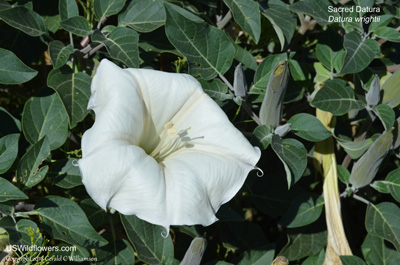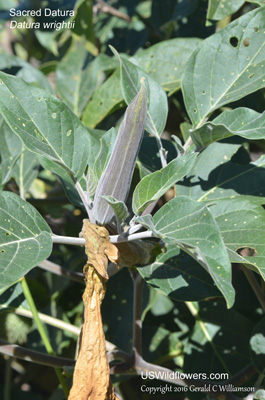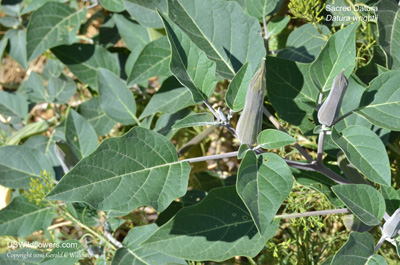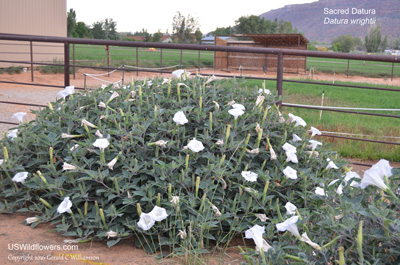Sacred Datura, Sacred Thorn-apple, Indian Apple, Angel Trumpet - Datura wrightii
|
Datura wrightii - Sacred Datura, Sacred Thorn-apple, Indian Apple, Angel Trumpet. The Datura genus scientific name has its origin in the word 'dhattura' - the Sanskrit word for 'white thorn-apple.' Thorn-apple is a reference to the prickly-spined fruit, and is one of the common names for the genus. The common name most commonly used in the United States for the genus is 'Jimsonweed' (which is also the most commonly used common name for the most widespread species in the genus, Datura stramonium). That common name is derived from the name of the first English settlement in North America, Jamestown, Virginia and originated because British soldiers were drugged with it near the town in 1676 by local farmers during Bacon's Rebellion, an inauspicious page in North American history.
Datura wrightii, Sacred Datura, is fairly widely distributed in North America, although its distribution out of its presumed native range - Mexico and the southwestern United States - is pretty scattered. It prefers well-drained soils of flood plains, blooming in late summer and early fall. Sacred Datura is a poisonous plant - it can be deadly. Parts of it are hallucinogenic, and as such it was (and possibly still is) used in Native American religious rites and continues to be used, sometimes with deadly results, by people seeking an hallucinogenic "trip".
Found in:
AL, AR, AZ, CA, CO, CT, FL, ID, IL, IN, KS, KY, MA, MD, ME, MI, MN, MO, NC, NE, NH, NJ, NM, NV, NY, OH, OK, PA, RI, SC, TX, UT, VA, WV, WY
Leave comments on Datura wrightii at this link. | 
Distribution of Datura wrightii in the United States and Canada:

Blue=Native; Grey=Introduced
Map from USDA Plants Database:
USDA, NRCS. 2017. The PLANTS Database (http://plants.usda.gov, 03 Apr 2025). National Plant Data Team, Greensboro, NC 27401-4901 USA.
Search Our Database: Enter any portion of the Scientific, Common Name, or both.
Do a general Google search of the entire site:
#ad
 Follow USWildflowers on Twitter
#ad
| | Site: Arches National Park, Grand County, UT Date: 2016-August-29 | Photographer: Gerald C. Williamson
Nikon D7000
Tamron SP 90MM f/2.8 AF Macro | | The blossom of Sacred Datura is usually white, although sometimes it may have a pink or purple tint. There are 5 pleated lobes, with a tooth-like protusion on the 5 outer, ribbed fold. | | 
| | Site: Arches National Park, Grand County, UT Date: 2016-August-29 | Photographer: Gerald C Williamson
Nikon D7000 | | Datura wrightii has 5 stamens (a characteristic of most of the Solanaceae family) which are clearly visible above the large corolla - quite a feat, since the corolla tube can be well over 6 inches long. The flower is quite large and showy - up to 6 inches across. | | Click on the photo for a larger image

| | Site: Catron County, NM Date: 2016-October-15 | Photographer: Gerald C Williamson
Nikon D7000 | | When I first saw this okra-like structure, I thought it was the fruit (forgetting the "thorn apple" common name for Datura species. Instead, however, this is the calyx of the unopened flower, which covers most of the long corolla tube when opened. An interesting characteristic of Datura calyces is that they are circumscissile at the base (I had to look up that term) - there is a ring near the base of the calyx which separates and allows the calyx to rotate with the corolla as it twists open. | | Click on the photo for a larger image

| | Site: Arches National Park, Grand County, UT Date: 2016-August-29 | Photographer: Gerald C Williamson
Nikon D7000 | | While the blossoms reportedly smell sweet, the foliage has a foul smell. The leaves are ovate, here showing an oblique base. The oblique base is carried into the lateral veins, which are offset from each other. The margins are entire or coarsely, shallowly lobed. | | Click on the photo for a larger image

| | Site: Moab, Grand County, UT Date: 2016-August-29 | Photographer: Gerald C Williamson
Nikon D7000 | | The Sacred Datura plant can be huge - a many-branched clump may sprawl 8 feet across and be 4 feet tall. | | Click on the photo for a larger image

|
References used for identification and information:
|
|
| |
| #ad
|
|







